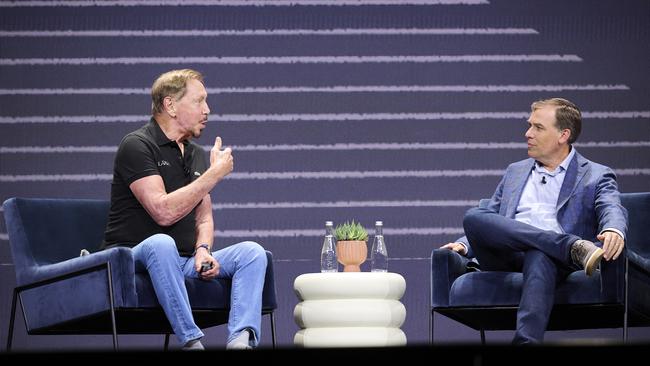Oracle takes nuclear option to power data centre as federal opposition seeks to overturn local reactor ban
The tech giant is designing a data centre with three small nuclear reactors, which would deliver more than a Gigawatt of power – enough to power more than 800,000 homes for a year.

Business
Don't miss out on the headlines from Business. Followed categories will be added to My News.
Multinational tech giant Oracle is designing a data centre with three small nuclear reactors, its co-founder Larry Ellison has revealed.
Mr Ellison, currently chairman and chief technology officer, says the artificial intelligence boom would help fund the three reactors which would deliver more than a Gigawatt of power – enough to power more than 800,000 homes for a year.
“We found the location and the power place, we’ve looked at it, they’ve already got building permits for three nuclear reactors,” he said.
Nuclear power is banned in Australia, so it is unlikely such a data centre could be built here, although the Coalition has a platform of building seven nuclear power plants across Australia at public expense.
In contrast, Mr Ellison’s proposal would be private sector funded. There would be questions about its financial viability, with construction costs adding billions to an already expensive $US100bn AI-enhanced data centre, and a significant lead time.
But it’s not unprecedented. Westinghouse last year signed an agreement to provide four AP300 small modular reactors to the privately funded UK Community Nuclear Power Limited. They would cost $US1bn each and should go online within a decade, said CNPL in a blogpost.
At its Las Vegas showcase event, Oracle said it was infusing AI at every level of its customer offerings, into infrastructure, data centres and into its enterprise and business software.
AI models would be trained centrally but “fine-tuned” to the needs of enterprises locally, and would run in installations alongside their data.
Whereas Amazon and Microsoft Azure public cloud locations were in the hundreds, Oracle’s would be “in thousands of places”, said Mahesh Thiagarajan, executive VP of Oracle Cloud Infrastructure.
“That’s the differentiated vision that we are going after,” he said. “We are welcoming every single enterprise out there to actually deploy our Oracle data centres next to wherever they want it. We have the capability now.”

Customers could still choose to run their Oracle installation and software in multiple regional cloud environments operated by Amazon, Google and Microsoft and Oracle itself. It was their choice.
The same applied to AI. They could use their preferred AI model. Oracle was well down the road in the AI stakes with OpenAI and X using Oracle infrastructure to train their large language models.
Mr Thiagarajan said AI was being applied to project risk analysis. AI models were trained on past projects and their degree of success to help predict future success. “We’re able to take a base set of data and train it very specifically on projects that have gone well versus not,” Mr Thiagarajan said.
Oracle has also added AI in its healthcare records systems. Its customers include Australia’s Royal Flying Doctor Service.
A local implementation of AI will run on the planes, said SVP Chris Chelliah. Patient sessions can be transcribed and codified, and once verified by the doctor, can generate prescriptions and after-care instructions.
Using Generative AI, Oracle software could examine specific patient data and match it with the latest drug discoveries and cancer treatment and suggest treatments. It could model the implications of a patient with specific illnesses taking a suggested regimen of drugs.
“We have a rich portfolio of very, very deep industry applications,” he told The Australian.
In construction, Oracle was embedding AI in its construction software to manage projects and construction site safety and security.
“We’re ingesting video in real time and sending alerts and notifications in real time to prevent accidents,” Mr Chelliah said. For example, a camera might notice a forklift about to reverse into a worker and send out alerts.
This could be applied to the transport to potentially head off disasters such as the Hunter Valley bus crash, where 10 people died and another 25 were injured due to erratic driving.
Mr Chelliah said that capability was there through work undertaken on the monitoring of autonomous driving.
“That’s exactly the capability that’s there now. We’re looking at a partner to effectively pick that up and roll that out across the transport infrastructure.”
Generative AI was also being added to Oracle’s small business oriented product, NetSuite, which Oracle acquired in 2016.
Co-founder and CEO of Netsuite Evan Goldberg gave the example of Generative AI automatically creating the sales descriptions of items in an online store or being promoted in an email campaign.
“We’ve pre-configured NetSuite to know what you might want to include, the price and some of the features … so you don’t have to pull that all together. It just does that automatically.”
“This year we’re giving customers the ability to customise how it operates on a field-by-field basis,” Mr Goldberg said.
More Coverage
Originally published as Oracle takes nuclear option to power data centre as federal opposition seeks to overturn local reactor ban




